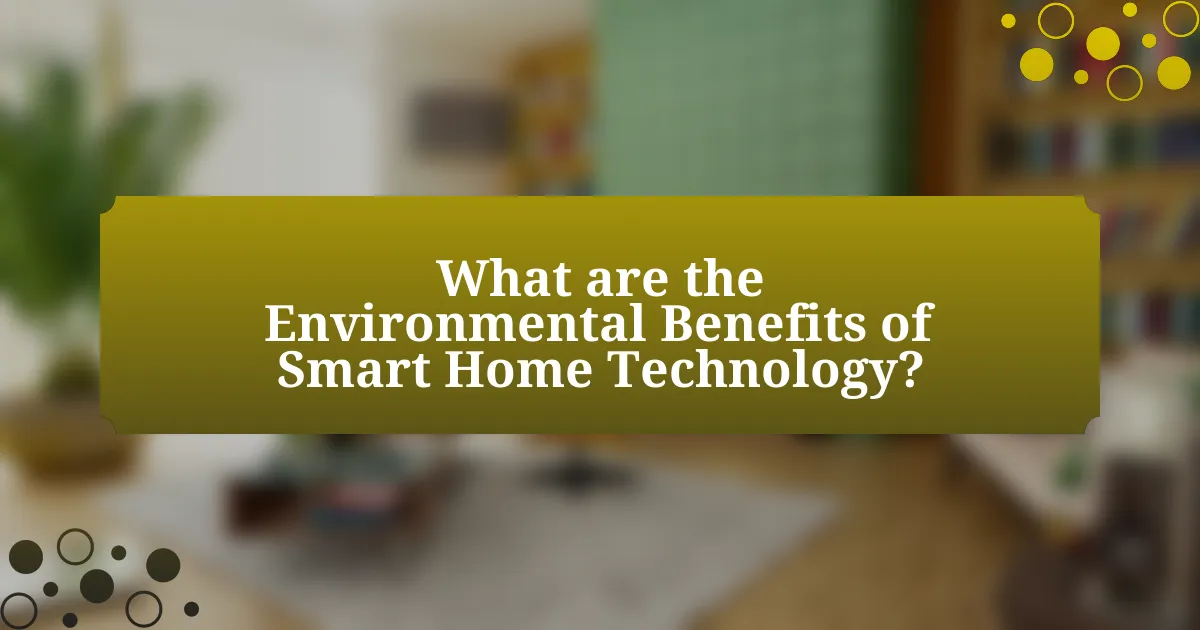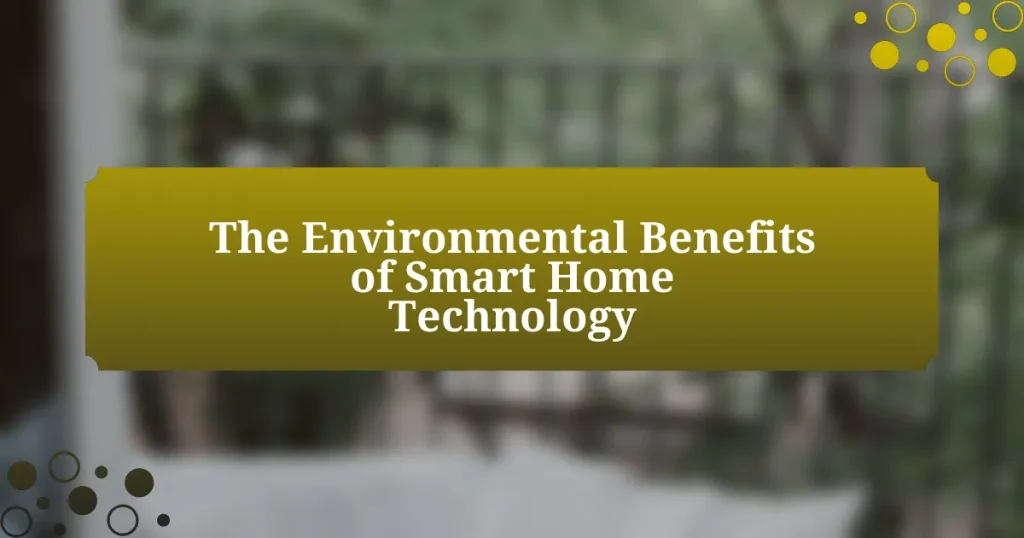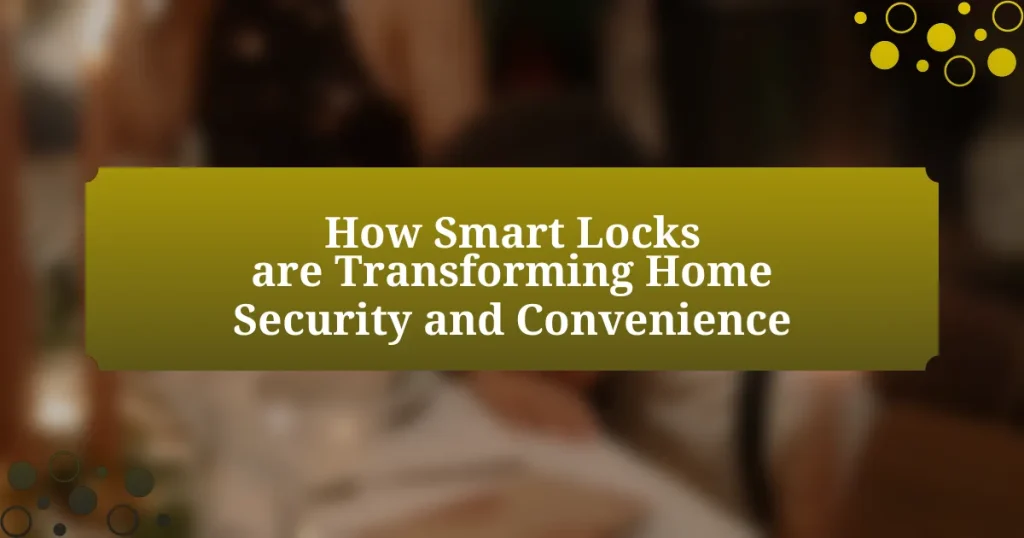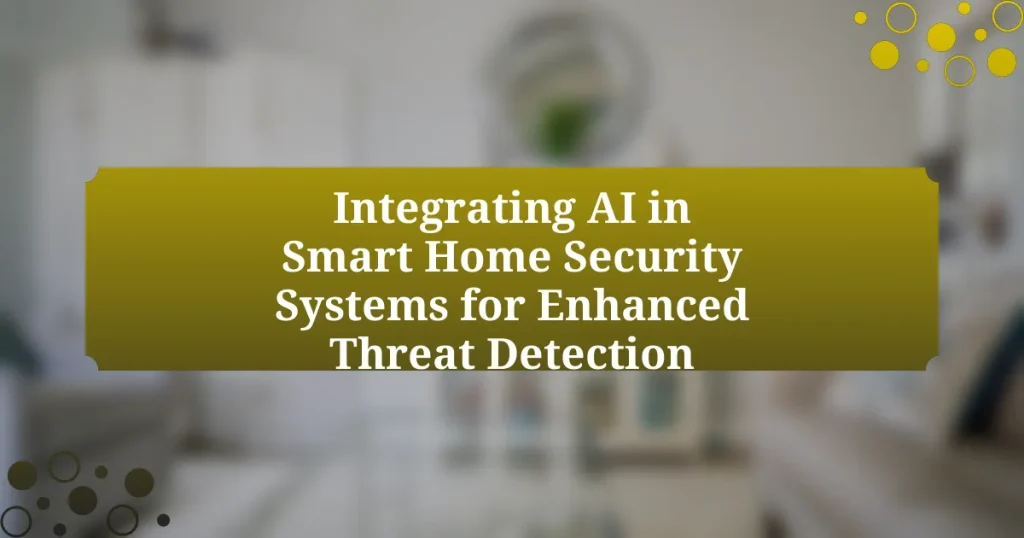Smart home technology plays a crucial role in enhancing environmental sustainability by significantly reducing energy consumption and carbon emissions. Key devices such as smart thermostats, lighting systems, and irrigation controls optimize energy and water usage, leading to substantial savings and lower ecological footprints. The article explores how these technologies contribute to energy efficiency, promote water conservation, and facilitate the integration of renewable energy sources, while also addressing potential drawbacks such as increased electronic waste. Additionally, it highlights best practices for homeowners to maximize the environmental benefits of smart home systems, ensuring a more sustainable living environment.

What are the Environmental Benefits of Smart Home Technology?
Smart home technology significantly reduces energy consumption, leading to lower carbon emissions. By utilizing smart thermostats, homeowners can optimize heating and cooling systems, resulting in energy savings of up to 10-15% annually, according to the U.S. Department of Energy. Additionally, smart lighting systems can automatically adjust based on occupancy and natural light, further decreasing electricity usage. These technologies not only enhance energy efficiency but also contribute to a more sustainable environment by minimizing the overall ecological footprint of residential energy use.
How does Smart Home Technology contribute to energy efficiency?
Smart Home Technology enhances energy efficiency by automating and optimizing energy usage in residential settings. Devices such as smart thermostats, lighting systems, and energy monitors adjust energy consumption based on real-time data and user preferences, leading to reduced waste. For instance, a study by the American Council for an Energy-Efficient Economy found that smart thermostats can save homeowners an average of 10-12% on heating and cooling costs annually. Additionally, smart lighting systems can automatically turn off when rooms are unoccupied, further decreasing energy expenditure. These technologies collectively contribute to lower energy bills and a reduced carbon footprint, demonstrating their significant role in promoting energy efficiency.
What specific devices enhance energy savings in smart homes?
Smart thermostats enhance energy savings in smart homes by optimizing heating and cooling based on user behavior and preferences. These devices, such as the Nest Learning Thermostat, can reduce energy consumption by up to 15% on heating and cooling bills, according to the U.S. Department of Energy. Additionally, smart lighting systems, like Philips Hue, allow users to control lighting remotely and set schedules, leading to significant reductions in electricity usage. Smart plugs and energy monitors also contribute by enabling users to track and manage energy consumption of connected devices, further promoting energy efficiency.
How do smart thermostats optimize heating and cooling?
Smart thermostats optimize heating and cooling by using algorithms and sensors to learn user preferences and adjust temperature settings accordingly. These devices analyze data such as occupancy patterns, external weather conditions, and historical usage to create efficient heating and cooling schedules. For instance, a study by the American Council for an Energy-Efficient Economy found that smart thermostats can reduce energy consumption by up to 10-15% annually, demonstrating their effectiveness in minimizing energy waste while maintaining comfort.
Why is water conservation important in smart homes?
Water conservation is important in smart homes because it enhances sustainability and reduces environmental impact. Smart home technologies, such as automated irrigation systems and water-efficient appliances, optimize water usage, leading to significant reductions in waste. For instance, studies show that smart irrigation systems can reduce water consumption by up to 50% compared to traditional methods. This efficiency not only conserves a vital resource but also lowers utility bills and minimizes the strain on local water supplies, contributing to overall ecological health.
What smart devices assist in reducing water usage?
Smart devices that assist in reducing water usage include smart irrigation systems, smart faucets, and water leak detectors. Smart irrigation systems, such as those from Rachio or RainMachine, optimize watering schedules based on weather data and soil moisture levels, leading to significant water savings—up to 50% in some cases. Smart faucets, like those from Moen or Delta, feature touchless technology and flow rate control, which can reduce water consumption by up to 30%. Water leak detectors, such as those from Flo or Aqara, monitor for leaks and alert homeowners, preventing water waste and potential damage. These devices collectively contribute to more efficient water management in households.
How do smart irrigation systems work to conserve water?
Smart irrigation systems conserve water by utilizing sensors and weather data to optimize watering schedules and amounts. These systems monitor soil moisture levels, rainfall, and temperature, allowing them to adjust irrigation in real-time, ensuring that plants receive the precise amount of water needed without overwatering. Research indicates that smart irrigation can reduce water usage by up to 50% compared to traditional methods, significantly minimizing waste and promoting sustainable water management practices.
What role does Smart Home Technology play in reducing carbon footprints?
Smart Home Technology significantly reduces carbon footprints by optimizing energy consumption and enhancing efficiency in residential settings. Smart devices, such as thermostats, lighting systems, and appliances, can be programmed or controlled remotely to minimize energy use during peak hours or when homes are unoccupied. For instance, a study by the American Council for an Energy-Efficient Economy found that smart thermostats can reduce heating and cooling energy use by up to 10-15%, leading to lower greenhouse gas emissions. Additionally, smart home systems can integrate renewable energy sources, such as solar panels, allowing homeowners to utilize clean energy more effectively, further decreasing reliance on fossil fuels.
How can smart homes utilize renewable energy sources?
Smart homes can utilize renewable energy sources by integrating solar panels, wind turbines, and energy storage systems to generate and manage energy efficiently. These technologies allow homes to harness natural resources, reducing reliance on fossil fuels and lowering greenhouse gas emissions. For instance, a study by the National Renewable Energy Laboratory found that homes equipped with solar panels can significantly decrease their electricity costs and carbon footprint, demonstrating the effectiveness of renewable energy integration in residential settings.
What impact do smart homes have on overall greenhouse gas emissions?
Smart homes significantly reduce overall greenhouse gas emissions by optimizing energy consumption and enhancing efficiency. Research indicates that smart home technologies, such as smart thermostats and energy-efficient appliances, can lower energy use by up to 30%. This reduction in energy consumption directly correlates with decreased greenhouse gas emissions, as less energy demand leads to lower fossil fuel usage in power generation. For instance, a study by the American Council for an Energy-Efficient Economy found that widespread adoption of smart home technologies could lead to a reduction of approximately 1.5 billion tons of carbon dioxide emissions annually by 2030.
How does Smart Home Technology promote sustainable living practices?
Smart Home Technology promotes sustainable living practices by optimizing energy consumption and reducing waste. Smart devices, such as thermostats, lighting systems, and appliances, can be programmed to operate efficiently, adjusting usage based on real-time data and user habits. For instance, smart thermostats can learn a household’s schedule and reduce heating or cooling when no one is home, leading to energy savings of up to 15% according to the U.S. Department of Energy. Additionally, smart lighting systems can automatically turn off when rooms are unoccupied, further minimizing electricity use. These technologies not only lower utility bills but also contribute to a decrease in carbon emissions, supporting a more sustainable lifestyle.
What are the behavioral changes encouraged by smart home systems?
Smart home systems encourage behavioral changes such as increased energy efficiency, enhanced security practices, and improved daily routines. These systems promote energy-saving habits by automating lighting and heating based on occupancy, which can lead to a reduction in energy consumption by up to 30%, as reported by the U.S. Department of Energy. Additionally, smart home technology encourages users to adopt proactive security measures, such as monitoring and controlling access remotely, which can decrease the likelihood of break-ins. Lastly, these systems help streamline daily activities through automation, leading to more organized and efficient household management.
How can smart homes facilitate recycling and waste management?
Smart homes facilitate recycling and waste management by integrating smart sensors and automated systems that monitor waste levels and optimize recycling processes. These technologies can track the types and quantities of waste generated, allowing homeowners to receive real-time feedback on their recycling habits. For instance, smart bins equipped with sensors can notify users when they are full or when specific materials are ready for recycling, thus reducing contamination and improving recycling rates. Studies indicate that homes utilizing smart waste management systems can increase recycling efficiency by up to 30%, demonstrating the effectiveness of technology in promoting sustainable practices.
What are the potential drawbacks of Smart Home Technology for the environment?
Smart Home Technology can have several potential drawbacks for the environment, primarily due to increased energy consumption and electronic waste. While smart devices aim to optimize energy use, their constant connectivity and operation can lead to higher overall energy demands. For instance, a study by the International Energy Agency found that the proliferation of connected devices could increase global electricity demand by 30% by 2040. Additionally, the rapid turnover of smart devices contributes to electronic waste, which is projected to reach 74 million metric tons globally by 2030, posing significant environmental hazards due to toxic materials in electronics.
How does the production of smart devices affect the environment?
The production of smart devices negatively affects the environment primarily through resource extraction, energy consumption, and electronic waste generation. Manufacturing these devices requires significant amounts of rare earth metals and minerals, which leads to habitat destruction and pollution from mining activities. For instance, the production of a single smartphone can involve the extraction of over 60 different elements, contributing to environmental degradation. Additionally, the energy-intensive processes involved in manufacturing smart devices contribute to greenhouse gas emissions. According to a study by the International Energy Agency, the production of electronics accounts for approximately 7% of global energy consumption. Finally, the rapid turnover of smart devices results in substantial electronic waste, with the Global E-waste Monitor reporting that 53.6 million metric tons of e-waste were generated in 2019, much of which is not recycled properly, leading to further environmental harm.
What are the implications of electronic waste from smart home devices?
The implications of electronic waste from smart home devices include significant environmental hazards and resource depletion. As smart home technology proliferates, the disposal of outdated or non-functional devices contributes to the growing global electronic waste crisis, which reached 53.6 million metric tons in 2019, according to the Global E-waste Monitor 2020. This waste often contains hazardous materials such as lead, mercury, and cadmium, which can leach into soil and water, posing risks to human health and ecosystems. Furthermore, the production of these devices consumes valuable resources, including rare earth metals, leading to unsustainable extraction practices. Thus, the lifecycle of smart home devices raises critical concerns regarding environmental sustainability and resource management.
How can homeowners maximize the environmental benefits of Smart Home Technology?
Homeowners can maximize the environmental benefits of Smart Home Technology by implementing energy-efficient devices and optimizing their usage patterns. Smart thermostats, for example, can learn user habits and adjust heating and cooling accordingly, leading to energy savings of up to 10-15% annually, as reported by the U.S. Department of Energy. Additionally, integrating smart lighting systems that utilize LED bulbs and motion sensors can reduce electricity consumption significantly, with studies indicating a potential reduction of 30-50% in lighting energy use. Furthermore, homeowners can utilize smart irrigation systems that monitor weather conditions and soil moisture, ensuring water is used efficiently, which can lead to a reduction in water waste by up to 50%. By strategically selecting and utilizing these technologies, homeowners can significantly lower their carbon footprint and contribute to environmental sustainability.
What best practices should be followed for energy-efficient smart home setups?
To achieve energy-efficient smart home setups, homeowners should prioritize the integration of smart thermostats, energy-efficient appliances, and automated lighting systems. Smart thermostats, such as the Nest Learning Thermostat, can reduce heating and cooling costs by up to 15% by learning user habits and adjusting temperatures accordingly. Energy-efficient appliances, which are often rated by the ENERGY STAR program, consume less electricity and water, contributing to lower utility bills and reduced environmental impact. Automated lighting systems, including smart bulbs and motion sensors, can significantly decrease energy usage by ensuring lights are only on when needed. Collectively, these practices not only enhance convenience but also lead to substantial energy savings and a smaller carbon footprint.
How can users effectively monitor and manage their smart home systems for sustainability?
Users can effectively monitor and manage their smart home systems for sustainability by utilizing energy management tools and automation features. These tools allow users to track energy consumption in real-time, enabling them to identify high usage patterns and adjust settings accordingly. For instance, smart thermostats can learn user habits and optimize heating and cooling schedules, potentially reducing energy consumption by up to 15%, as reported by the U.S. Department of Energy. Additionally, integrating smart lighting systems that adjust based on occupancy can further minimize energy waste. By leveraging these technologies, users can not only enhance their home’s efficiency but also contribute to broader environmental sustainability efforts.














